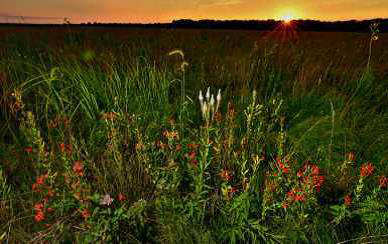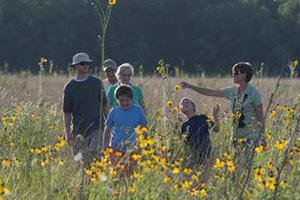Pollinator Habitat Development and Enhancement
Why is pollinator habitat important?
Quality pollinator habitat provides the following benefits:
- Diverse native plant communities provide mutually beneficial shelter and food for a wide variety of pollinator and wildlife species.
- Pollinators rely on blooming flowers for nectar and pollen, and leaves of host plants for larval food.
- Birds feed on the fruits and seeds of the native plants.
- Insect pollinators are prey for wildlife.
- Vegetative cover provides habitat for small mammals. Those animals serve as food for larger predators such as hawks, foxes and owls.
- Pollinator habitat improves water quality because of native plants’ ability to filter run-off and groundwater.
A good rule of thumb for "pollinator habitat" is to provide at least three blooming native plant species in each of the early, middle, and late periods of the growing season.
Get involved with Indiana DNR to restore habitat
The Indiana DNR actively promotes and establishes pollinator friendly habitat. This habitat work is accomplished through many programs offered through the Division of Fish & Wildlife or with conservations partners’ programs. These programs provide technical and financial help to landowners or managers interested in establishing and enhancing habitat.
Pollinator friendly habitat programs
To participate in these programs, contact a DNR Grassland or District Biologist. From there, you can enroll in eligible programs, receive technical advice, and apply for potential funding to help offset the costs of the habitat establishment. View a list of potential financial assistance for habitat projects.
- Monarch Wings Across the Eastern Broadleaf Forest
The Division of Fish & Wildlife partnered on this program in Indiana with the U.S. Fish and Wildlife Service’s Partners for Fish and Wildlife Program from 2016 to 2019. This program was coordinated by the Pollinator Partnership and funded by the National Fish and Wildlife Foundation with a goal to enhance 4,688 acres of monarch habitat.
Thanks to concerned and engaged Hoosier citizen scientists, the project:
- Organized and trained volunteers, including community, agency, corporate partners, Master Gardeners and Naturalists, high schoolers, and private citizens in Indiana.
- Created a network to collect seed from 20 native monarch nectar and host plants throughout our target states in the Eastern Broadleaf Forest ecoregion.
- Formed teams of dedicated volunteers statewide.
- Sent native seed to be processed, propagated and returned to the landscape in plugs and seeds for monarch restoration projects.
- View regional accomplishments here.
- An extension and expansion of this project called Project Wingspan is currently operating in a nine-state target region of Arkansas, Illinois, Indiana, Michigan, Minnesota, Missouri, Ohio, Pennsylvania, and Wisconsin. Through a series of monarch habitat enhancement activities with the goal of enhancing and securing over 15,000 acres of high-quality monarch and RPBB habitat. You can learn more and get involved here.
- Grasslands for Gamebirds and Songbirds (GGS)
Grasslands are declining across Indiana and throughout the nation. The Indiana State Wildlife Action Plan identifies this loss as the single greatest threat to Indiana’s wildlife. Many grassland bird populations are already showing significant decline. The loss of pollinating insects and the plants they depend on are also a growing concern. GGS is a partnership with other conservation agencies, including DNR, USDA Natural Resources Conservation Service, Natural Resources Foundation, non-profit conservation groups, private industries and other sponsors to:
- Develop and improve grasslands and pollinator habitats in targeted areas in Indiana.
- Improve soil health and water quality.
- Improve species diversity.
- Increase hunting, birding and outdoor recreation opportunities.
- Improve overall human health.
- Increase funding to local economies.
- Preserve cultural heritage.
Learn more about the program.
- CORRIDORS
CORRIDORS is a Division of Fish & Wildlife program to develop habitats for grassland-dependent species and to foster improved pollinator habitat along roadways and waterways within prioritized conservation opportunity areas. CORRIDORS is a partnership between the Indiana Department of Transportation (INDOT), USDA Natural Resources Conservation Service (NRCS), Pheasants Forever and Quail Forever to:
- Provide technical and financial assistance for establishing wildlife habitat on your property.
- Get rid of invasive species.
- Address erosion, sedimentation or other water-quality and soil-health concerns.
- Provide aesthetic benefits.
Learn more about the program.
- Urban Wildlife Habitat Cost-Share Program
This program reimburses a portion of the expenses incurred by an entity for developing urban wildlife habitat as specified in a management plan.
- Projects must have at least one other partner as a financial contributor.
- These habitat projects are more often than not beneficial to pollinators, such as the monarch butterfly.
- To participate in this program, the project must exist within an identified urban priority habitat area (greater Indianapolis, greater Fort Wayne, South Bend/Mishawaka/Elkhart regions. View a map of the eligible regions.
- Wildlife Habitat Cost-Share Program
This program reimburses a portion of the expenses incurred by a landowner for developing wildlife habitat as specified in a management plan on lands of five or more acres.
- These habitat developments are often co-beneficial to many pollinators, including the monarch butterfly through the establishment of native grasses and forbs.
- Gamebird Partnership Program
This program reimburses a portion of the expenses incurred by a landowner for developing Northern bobwhite, ring-necked pheasant, American woodcock, mourning dove, ruffed grouse or wild turkey habitat.
- The Division of Fish & Wildlife administers this program in partnership with local not-for-profit conservation organizations such as Pheasants Forever/Quail Forever or the National Wild Turkey Federation.
- These habitat developments are often co-beneficial to many pollinators, including the monarch butterfly.
- Conservation Reserve Program
The Division of Fish & Wildlife provides technical assistance to the Conservation Reserve Program, a USDA Farm Bill program that establishes habitat for pollinators and wildlife species on private lands throughout Indiana.


